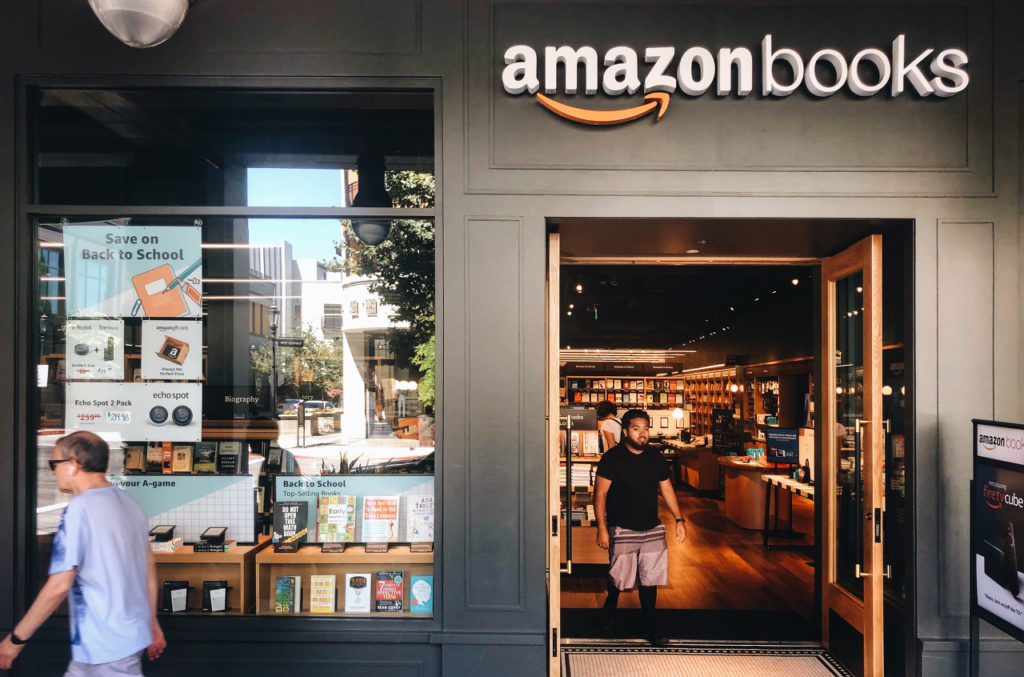
If you stroll down the path from the entrance of Santana Row, you’ll stumble upon Amazon’s offline specialty bookstore, Amazon Books. Since opening its first store in Seattle in 2015, Amazon has been cautiously expanding to 16 stores across the U.S. as of August 2018, perhaps mindful of the criticism of encroaching on small businesses. This careful expansion feels less like a takeover of the offline world and more like a test for new opportunities.
The spot of the Amazon Books store in Santana Row used to be occupied by the offline bookstore Barnes & Noble, which carries significant symbolism. Once omnipresent across the U.S., Barnes & Noble was one of the offline businesses most impacted by Amazon’s rise. They tried to survive by releasing the Nook, an e-reader device like the Kindle, but replicating a business model without considering the ecosystem wasn’t enough. Eventually, they had to concede the bookstore sector to Amazon, with their market capitalization reduced to a quarter of what it was in their peak year, 2006.
Amazon, which trampled offline bookstores with online business, now sets up an offline store in their place? It’s quite ironic. For Barnes & Noble, it must be a blow to their pride, especially since the premium probably wasn’t that high. 💔
Amazon Books, of course, has several differences from traditional offline bookstores. You can check book information or prices through barcode scanners dotted around the store, or make linked purchases using the Amazon app. But that’s just Amazon being Amazon. 📚
Personally, beyond those digital details, I want to talk about this store from the perspective of a customer who wants to buy a book. After all, their goal would have been to create a model that drives more sales. 💡
What value
can we deliver through user experience
to earn customer trust
and turn it into sales
to build a sustainable ecosystem?
Amazon uses all the information it has gathered online to carefully select items that might pique customers’ interest. Instead of displaying every book in their massive inventory, they showcase only those that have sold well or caught significant attention. Aside from Amazon devices, all other products in the store are top sellers or have excellent reviews in their categories. They add an analog touch by displaying book covers and attaching reviews to all items. 🛍️
Attaching reviews or information tags to books has been a common practice in many offline stores for a long time. I fondly remember seeing handwritten notes from bookstore staff or customers in indie bookstores across the U.S. and Europe. However, Amazon’s tags, selected through collective intelligence, offer a statistically higher reliability. 📈
When classifying books, they actively use pattern analysis from Amazon and Kindle data. For instance, right at the entrance, you see a stand titled ‘Most-Wished-For Books on Amazon.com’, showcasing books frequently added to wishlists. On each bookshelf, popular books are lined up on the left, with books bought by customers who purchased those popular books on the right, encouraging continued interest. The key is that they’ve maximized the use of decades of accumulated data analysis techniques, resulting in an impressively high similarity reliability. 📊
They even create intriguing sections using regional data, like ‘Books Popular in This Area’ or Kindle data for ‘Books You Can Finish in Three Days’. While defining sections and arranging books is core to traditional offline bookstores, these titles, based on customer responses rather than a few staff ideas, have a higher chance of resonating with customers. 📚✨
Amazon Books is a pilot project for testing whether they can implement a successful O2O (Online to Offline) business model. Their goal is likely to overcome the showrooming phenomenon—where customers browse offline but purchase online—and create an ecosystem where user experience flows seamlessly between online and offline. While there are still noticeable shortcomings and inconveniences, Amazon will undoubtedly achieve its goals slowly and steadily. 🚀
However, the sad reality is that only massive companies that can invest in both online and offline can currently conceive such an O2O model. There’s a need to develop a model that giant corporations and small businesses can organically execute together. 🌍
It’s also regrettable that personal experiences are becoming more uniform and generalized. The joy of unexpectedly discovering a book that no one knew existed and bringing it home is slowly fading. It’s sad that fewer people are reading books, but it’s also depressing that fewer people are writing them. While companies must make money and customers should derive meaningful value quickly, I still cherish the experience of lazily reading a book on a Sunday morning that has no practical use in my life. 📖☕
Personally, wandering around the enormous Barnes & Noble in Manhattan until my legs hurt, admiring beautiful books and albums, was far more enjoyable than browsing Amazon Books, where only the most likely purchases are displayed. 🎶📚
Leave a Reply